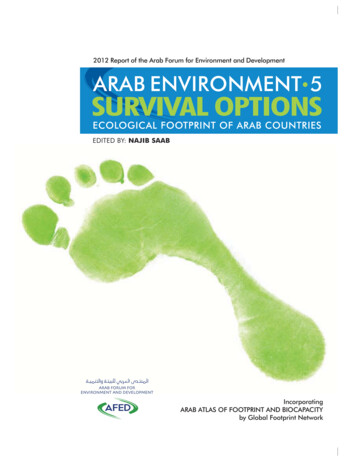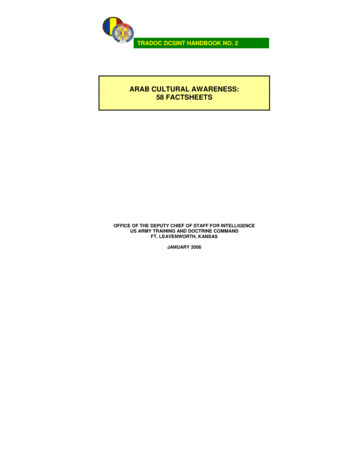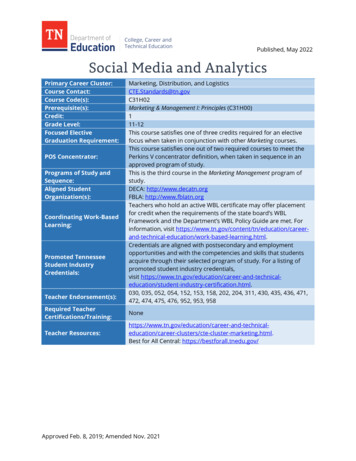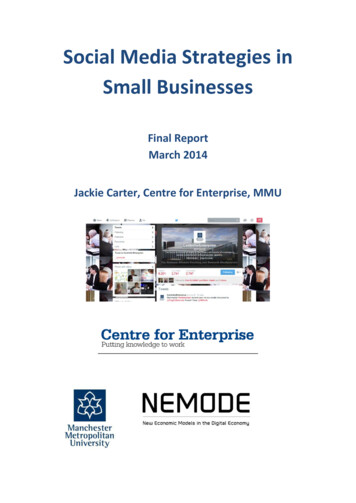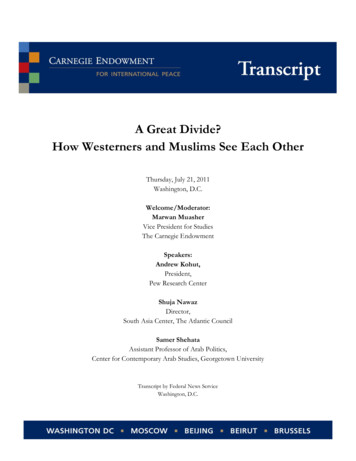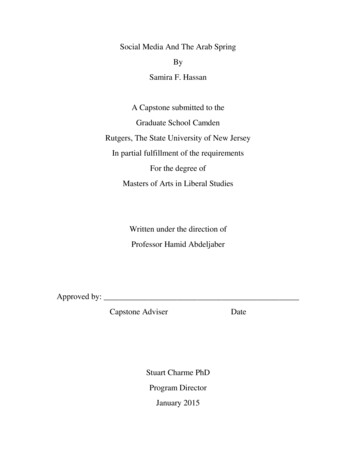
Transcription
Social Media And The Arab SpringBySamira F. HassanA Capstone submitted to theGraduate School CamdenRutgers, The State University of New JerseyIn partial fulfillment of the requirementsFor the degree ofMasters of Arts in Liberal StudiesWritten under the direction ofProfessor Hamid AbdeljaberApproved by:Capstone AdviserStuart Charme PhDProgram DirectorJanuary 2015Date
AbstractIn late of 2010 and during 2011, the Arab countries saw a series of large scale political uprisings.Facebook, Twitter, YouTube, and other forms of social media have played a major role in theplanning, acceleration, and even the preparation of some of the uprisings and revolutions that tooplace in the Middle East at this time. Social media was employed effectively to awaken the Arabpeople and to mobilize them to fight against repressive regimes in their drive for greater freedomand independence. This paper will discuss the cause of the uprisings. In addition, the role ofsocial media in the Middle East before the revolutions and the impact it had on the uprisings andrevolutions known as the Arab Springs will be examined.2
Table of ContentsAbstract . 2Introduction . .4Chapter OneRoot Causes of the Uprisings. .7Chapter TwoRole of Social Media in the Middle East Prior to the Revolutions . 13Chapter ThreeImpact of Social Media on the Arab Revolutions of 2011. . 17Conclusion 34Bibliography .363
Social Media And the Arab SpringIntroductionWhy does every nation on Earth move to change their conditions except for us? Whydo we always submit to the batons of the rulers and their repression? Didn’t thePalestinians resist with stones and knives? Didn’t Marcos and Suharto and Milosevicand Barri fall? Did the Georgian people wait for the Americans to liberate them fromtheir corrupt President? How long will Arabs wait for foreign saviors?Talk show host Faisal Al-QassemAl Jazeera, December 23, 2003(Lynch, 7).The Arab Spring started because people were fed up with the authoritarian regimes thatdominated their respective countries. The Arab world had been struggling to change theirpolitical system for decades; be they the leftist groups or the Islamic groups, their efforts topeacefully change the systems have failed. The protests that started in 2011 wouldn’t haveevolved into such a massive phenomenon if it weren’t for the widespread discontent overunemployment, the loss of hope, corruption levels, and low living standards. The anger felt bymillions of graduates who couldn’t find jobs to earn a living added to the level of resentmenttoward the regimes. A death of a 26-year-old Tunisian man named Mohammad Bouazizi wasthe trigger that led to the uprisings. Bouazizi was a street vendor and the breadwinner for hiswidowed mother and siblings. On December 17, 2010, he set himself on fire in front of amunicipal building after an incident during which he was humiliated by a female police officerwho wouldn’t allow him to continue selling his wares. No one knows for certain why Bouaziziset himself on fire. Perhaps it was frustration and humiliation that drove him over the edge;however, his final deed led to the country’s dictator, Zine al-Abidine Ben Ali, being forced outof office. Within a month of this event, hundreds of thousands of youth protestors had taken to4
the streets in almost every Arab country. All the protestors wanted to overthrow the regimes thatwere in place in the Arab world, and almost all of them waved the same banners. As stated byMarch Lynch in his book The Arab Uprising, “[they] fed off each other’s momentum and felt thepain of each other’s reversals” (7). More than anything, the people in the Middle East wereyearning for better lives and democratic nations. Over the next year, waves of protests leftmajor changes in their wake: revolutions in Tunisia and Egypt culminated in the downfall ofthese two regimes; a civil war in Libya resulted in the fall of its regime; civil uprisings took placein Syria and Yemen; and major protests in Bahrain, Jordan, Morocco, Algeria, Oman, Iraq, andminor protests in Kuwait, Saudi Arabia and Sudan. In an article titled “The Arab Revolutions of2011 are like Europe in 1848 and 1989,” author Anne Appleabaum argued that the Arabrevolutions of 2011 were messy and complicated: “Each revolution must be assessed in its owncontext, each had a distinctive impact. The revolutions spread from one point to another. Thedrama of each revolution unfolded separately. Each had its own heroes, its own crisis. Eachtherefore demands its own narratives” (Salih, 2013). She argues that each country had adifferent reason for its revolution, and the revolutions were a product of multiple changes,whether it is economic, technological, or geographical.Despite the fact that many Arab countries share the same language, culture, religion, andhistory, they differ in their political and ideological thinking. But for the first time in their longhistory, all Arabs were able to experience one world, a world with no borders, boundaries, orcensorship. The internet presented the people in the region with the ability to engage inconversations regarding matters that were once forbidden. They were able to discuss issuesabout religion that was taboo, women’s rights, governmental issues, and many other matters.The internet gave Arabs the opportunity to express themselves freely without boundaries, thus5
enhancing and stimulating social and intellectual interactions. Long before the uprisingsoccurred in the Middle East, social media had been lauded as one of the key factors enablingpopular uprisings and social movements. This has provided further hype for new digital media,which were already being touted as tools for social change, liberation, and the representation ofmarginalized or oppressed voices. Thanks to satellite television stations like Al-Jazeera and theincreasing presence of the internet, the follies of the Arab leadership were on full display to askeptical Arab public. Arab leaders could no longer go about their business in private whilesimultaneously crushing any signs of discontent. Their people now had access to informationand the ability to express their opinions publically, far beyond anything the region had everbefore known. Digital media provided important new tools that allowed social movements toaccomplish political goals that had previously been unachievable. “And judging by the reactionsof the dictators and other desperate political elites, digital media have become an important of amodern counterinsurgency” (Howard & Hussain, 18). Social media was effective in awakeningthe Arab people and giving them the power to fight against repressive regimes in their drive forgreater freedom and independence. This paper will discuss the causes of the Arab Spring andhow social media played a role in the Middle East before the start of the revolutions in 2011. Itwill further examine the impact social media had on the uprisings and revolutions known as theArab Spring.6
Chapter One:Root Causes of the UprisingsIf anyone asked a Middle Eastern person living in one of the Arab countries about thecause of the Revolutions, many will give the same, seemingly obvious, answer: these wererevolts against repressive regimes, autocracy and corruption. A combination of factors havebeen identified as having led to the protests. “These include issues such as dictatorship orabsolute monarchy, human rights violations, government corruption, economic decline,unemployment, extreme poverty, and a number of demographic structural factors such as a largepercentage of educated but dissatisfied youths within the population” (Ogbonnaya, 2013).Throughout history, revolutions have occurred as a result of similar issues-Corruption,high taxes, unemployment- which led to political and social change. In the 18th century, one ofthe most famous revolutions was the French Revolution; it was caused by economic difficulties,higher taxes, food shortages, and political discontent. It’s long been understood that if a group ofpeople feels oppressed, they will one day revolt and demand their rights.that’s how therevolutions in the Arab world started: each Arab country revolted against their respective regime.TunisiaBouaziz’s self-immolation was a cry for help, but this act promoted a revolution inTunisia because demonstrations shared his assumed motives. The prohibitive rise in the cost ofliving, frustration over rampant unemployment (particularly among college graduates), contemptfor the authorities, and the brutally of the police were among many factors that led to the revolt.The protests that swept through the country in late 2010 and early 2011 were triggered bydemands for social and economic change. Demonstrators were protested against unemployment7
and low living standards. Thousands of people, mostly students, marched to demonstrate theirsupport for the Tunisian uprising. “Sit-ins, demonstrations, marches under various ralliesdenounced low wages, the arbitrary hiring practices of some companies and the government,precarious working conditions, and the absence of work at all” (Guessoumi, 2012). Thedemonstrations also criticized the Tunisian media’s inadequate reporting, thus demanding better,truthful coverage.EgyptEgypt’s revolution was inspired by the successful protests in Tunisia that led to thedownfall of the regime. Although Egypt’s revolution, which started on January 25, 2011, wassparked by the successful Tunisian revolution, it had already been brewing for decades. Theprimary reasons for the uprising against the regime were corruption, economic failure, and theEgyptian’s people thirst for democracy and legitimate elections. Since the early 1980s, HosniMubarak had won every election with a voting percentage of 99%. These results did not foolanyone but were forced upon the people whether they liked it or not. Additionally, Mubarak hadbuilt a powerful, notorious police state. Tight internet controls, beatings and the kidnapping ofwho dared to defy the government, torture, police brutality, and bribes ran rampant underMubarak’s regime. One of the famous slogans that people knew by heart in Egypt before therevolution was, “sent behind the sun,: which referred to the pervasive kidnapping by the policeand the disappearance of citizens (Corrimal, 2011). Another phrase, “walk near the wall,” meantto walk one’s head down to avoid any eye contact with the police so as to avoid interrogation(Corrimal, 2011). Before the uprising started in Egypt, people had already been extremely angryabout the death Khalid Said. Khalid Said had been beaten to death by the police who went to acyber café to interrogate him. His death galvanized an already worked-up Egyptian youth who8
were fed up with the police and their brutality. The other major factors leading to the Egyptianrevolution were economic distress and low incomes. For instance, in Egypt there was a hugeincome gap under the rule of Hosni Mubarak. “One half of Egyptians live on a 2/ day or less.The average per capita income in the country is just 6,200” (Jamoul, 2012). Egypt was knownas one the countries where food prices were constantly on the rise. Half of the Egyptianpopulation could not afford to buy food; they lived on bread. When I visited Egypt in 2009, oneof my husband’s friends explained to us that they never ate meat as they could not afford it. Inan ordinary Egyptian household, the notion of eating meat was unattainable. “According to FAO[Food and Agriculture Organization of the United Nations] global food prices reached a recordhigh in January 2011, surpassing the levels reached during the 2007-2008 food crises” (Gana,2012). As several analysts have shown, the rise of food prices in most Arab countries led topeople being vulnerable, and this was undoubtedly a causal factor in the social unrest. “Impactsof the food crisis have been expressed in growing financial pressure on public budgets and cutsin food subsides” (Gana, 2012). This had major consequences for household budgets, forcingpeople to spend most of their money on food. The Egyptian people were fed up with the corruptregime, bribery, and the government-controlled army and police who beat people with impunity.They wanted democracy and justice.LibyaWith the success of the revolutions in their neighboring countries, Tunisia and Egypt, thepeople of Libya were inspired to start a revolution of their own. Like Tunisia and Egypt, theyhad been rule by a dictator for 42 years in a very erratic and unpredictable manner. Educationwas very important in Libya : “According to United Nations Educational, Scientific and CulturalOrganization (UNESCO), 99.9 percent of youth are literate, 99 percent of the appropriate-age9
population is enrolled in primary education, and 71 percent of the appropriate-age population isenrolled in secondary education” (Sizemore, 2014). However, the type of education provided forLibyans were determined by the country’s leader, Muammar Al Qaddafi. For example, in highschool the history books depicted Qaddafi as a hero who freed Libya from the previous regime.The curriculum was based on The Green Book, a book written and published in 1975 thatincludes Qaddafi’s theories and ideologies. “The book rejects liberal democracy, capitalism, andWestern ideals, and even demonizes any childcare which is performed by any other individualthan the mother, thus discouraging females from seeking careers” (Sizemore, 2014). Eventhough Gaddafi tried to teach his people his ideologies, the injustices that were rampant withinLibyan society could not be ignored. Gaddafi used oil returns and income to maintain power, tofund and strengthen his grip on power, and to finance many anti-Western terrorist organizations.In 2010 alone, “ 41.9 billion worth of oil was exported out of a country with only 6.6 millioninhabitants, yet Libya was known for high rates of poverty and unemployment” (Sizemore,2014). The Libyan people, who were mostly educated, lived in a country that had a feweconomic and employment opportunities. “Estimations of unemployment in 2009 were 20.67%.Unemployment among men is 21.55 percent and at 18.71 percent among women” (“Libya’sUnemployment at 20.7 percent”). Indeed, Libya had the highest number of unemployed peoplein North Africa, leading to increasing youth frustration. This deprivation became a severeproblem, and the concomitant anger was evident among the masses of protestors who swarmedthe streets of Libya during the Arab Spring.10
SyriaIn March 2011, Syria followed in the footsteps of the other Arab countries. Syrians, likethe people in many of its brother-state countries, were tired of their ruthless regime. But oneincident that might have ignited the Syrian revolution was:Influenced by Arab Spring protesters on TV, in March 2011, children between the agesof nine and fifteen in Daraa wrote anti-regime graffiti on the walls of their school andwere promptly apprehended by security forces. Upon release, their bodies and facesshowed signs of severe torture; some had burns and others had had their fingernailspulled out (Al Saleh & White, 2013).This event, also known as “Friday of Dignity,” was the main reason for the popular revolt.These children, whose only crime was to express their feelings on the walls of their school, weretortured and some were killed. This violent punishment angered and enraged the Syrian peoplewho have been for decades oppressed by the Assad regime. “For the youth who dominate themajority of Syria have a rate of 20% of unemployment” (Roudi, 2011). Given these two sourcesof discontent, the Syrian people started the revolution by going out into the streets callingpeacefully for the end to the Assad regime.Yemen, Bahrain, Jordan, Morocco, Algeria, Kuwait and Saudi ArabiaIn Yemen, Bahrain, Jordan, Morocco, Algeria, Kuwait, and Saudi Arabia, protests tookthe form of sustained campaigns involving thousands of citizens who used civil protesttechniques: strikes, demonstrations, marches and rallies. The people of these countries had hadenough of their low standards of livings, unemployment, dictatorships, and the brutality of the11
security forces. Although their protests were not as large as those Tunisia, Egypt, Libya, andSyria, the people took to the streets to have their voices heard across the world. With the wholeworld watching through Facebook, Twitter and YouTube, the Arab people screamed for justiceand openly elucidated their dream of living with dignity and freedom in democratic countries.12
Chapter Two“Social media is a tool for of liberation and empowerment.The freedom to communicate openly and honestly is notSomething to be taken for granted” (Omidyar, 2014).Role of Social Media in the Middle East Prior To the RevolutionsThe use of social media has become the most pervasive phenomena in today’s society.Children and adolescents use social media like Facebook, Twitter, and MySpace as a means forsocial interaction, while gaming sites, virtual worlds, and videos from YouTube have become theentertainment tools for today’s youth. “Social media and networking have come to define a newgeneration of communication and have created a platform that possesses limitless abilities toconnect, share, and explore our world” (Bhulyn, 2011). Social media is one of the mostimportant “global leaps forward in human history” (Omidyar, 2014). It provides human beingswith the means for self-expression and mutual understanding. “It enables rapid information ofnetworks and demonstrates our common humanity across cultural differences” (Omidyar, 2014).It’s a phenomenon that connects people and their ideas like never before. Prior to the existenceof social media, the Middle East only had news media outlets, where everything was censored bythe region’s governments. No one was allowed to tell the truth, and if any organization dared todo so, the government would silence them. Before the revolutions, the Middle East hadwitnessed tremendous growth in digital communication technologies in a way that made itpossible for people to express their frustration via social networking. “Using these sites allowedpeople to communicate in real-time and thereby was effective in developing democracy becausesocial media sites gave people a voice to express their opinions about government, television,political leaders, and any other issues of concern” (Bhulyn, 2011). Sites like Facebook and13
Twitter allowed people in the Middle East to control communication and to have the powerthey’d yearned for.The Arab youth were the primary users of social networks although during the newmillennium only 10% had access to the internet. In 2000, Arab countries were filled withinternet cafes that many of the youth would use as their primary internet source. They wouldspend hours playing video games and socializing in chat rooms with people from around theworld. The internet was only one of many forms of connectivity employed by large numbers ofyouth. “At the beginning of 2009, a little over half of Egyptians had cell phones. By the end of2010, nearly three-fourths had one, and there were hundreds of thousands of new connectionseach month” (Cole, 9). By 2009 in Tunisia, literally everyone--the rich or the poor--had a cellphone. The young people interviewed by Cole felt that “[it] was very important for them to havecell phones for their activism” (Cole, 11). Because of the country’s filtered and one-sided newsbroadcasting, the youth used text messaging to spread word of their discontent. When therevolution first began in Libya, the government shut down the phone networks and the internet,but the youth and activists used text messaging via their cell phones to communicate. A 2005article on marketing to the Arab youth in a web-based magazine in Dubai spoke of “the ArabGeneration Y and how advertisers could reach its members” (Cole, 11). Cole further explainedhow Generation Y spent most of their time surfing the internet and reading the news on their cellphones rather than printed newspapers and magazines. The youth of the Middle East werehooked on websites like Maktoob, which allowed them to share music, videos, and video games.“Other portal sites, such as Mazzika, concentrated on offering MP3 pop up music, and as theWeb 2.0 unfolded, it became possible for Melody to offer music videos” (Cole, 11). By 2010,there were tens of millions of Arab youth on the internet. “In that same year, 15 million of the14
Middle East and North Africa (MENA) were using Facebook. 50% of them have selectedEnglish as their primary language to use Facebook, 25% chose French and just 23% selectedArabic” (Middle East & North Africa Demographics, 2010). “Youth between the ages of 15 to29 made up three quarters of Facebook users three years later” (Cole, 11). “50% were under theage of 25 and 37% were female users” (Middle East & North Africa Demographics, 2010).See figure 1 for further information regarding social media usage in Arab Countries.Figure 1: Social media use in the Middle East in 2010. [Facebook Statistics in the MENARegion]“From Morocco to Bahrain, the Arab world has witnessed the rise of an independentvibrant social media and steadily increasing citizen engagement on the Internet that is expectedto attract 100 million Arab users by 2015” (Ghannam, 2011). With so many of the youth surfingthe web, they turned to the internet to express their rage and dissatisfaction with the problemsthey faced each day, such as unemployment, rigid economic conditions and government15
corruption. “They have utilized the internet to rally the populace to their cause" (Al-Naway &Khamis, 2012).Prior to the Arab spring, some countries in the region had had vibrant online civilsocieties where open political conversations took place beyond the control of governmentcensorship. Even before their revolutions began, Tunisia and Egypt had active bloggers. “Oftenthe most critical government coverage of government abuse was done not by newspaperreporters, but by average citizens using their access to the internet in creative ways” (Howard &Hussain, 37). In 2007, a video of the Tunisian president using an airplane to visit one ofEurope’s most prestigious shopping destinations became notorious. Once the video went viral,the Tunisian government cracked down on Facebook, Twitter, YouTube, and other onlineapplications. In Bahrain it was Bahrainonline.com that first attacked the prime minister forcorruption, and by 2010, “every country in the region had an online source for credibleinformation about corruption and regime abuse, spaces for political conversations” (Howard &Hussain, 38). Given all the advances that social networking offered Arab citizens, it was met bylimitations and challenges from the respective regimes. Arab governments waged widespreadcrackdowns on journalists, bloggers, and human rights activists. “Hundreds of Arab activists,writers, and journalists have faced repercussions because of their online activities” (Ghannam,2011). For example, in Egypt a blogger named Kareem Amer was imprisoned for more thanfour years, according to authorities, “insulting Islam and defaming Mubarak” (Ghannam, 2011).“In Syria, 19-year-old Tal al-Mallouhi was said to be the youngest Internet prisoner ofconscience in the region and in December 2010 marked her first year in prison, mostlyincommunicado, for blogging through poetry about her yearning for freedom of expression”(Ghannam, 2011). In Bahrain, a social networking blogger, Ali Abduleman, was imprisoned for16
“allegedly posting false news on his popular website BahrainOnline.org” (Ghannam, 2011).These are just some of the people in the Arab world who were imprisoned for posting theiropinions online. There were--and still are--thousands of bloggers who are punished for bloggingthe truth and making their voice heard. In the hands of average people, digital media became ameans of documenting corruption and regime abuses.17
Chapter Three“If you want to liberate a society, just give them the internet”Wael GhonimImpact of Social Media on the Arab Revolutions of 2011No one could have imagined that the Arab revolutions would start because of the actionsof a young man named Muhammad Bouazizi. His self-immolation caused the end of theTunisian and Egyptian regimes and the start of civil wars in both Libya and Syria. He inspiredtens of thousands of protestors to go onto the streets chanting for freedom and democracy. TheArab spring had many aspects, but one of these was social media, which had the power to put ahuman face to political oppression. Bouazizi’s story was told over and over again on Facebook,Twitter, and YouTube, inspiring other people to organize protests and challenge their regimes.“Indeed, Facebook became the information infrastructure that supported political organizingindependent not only of the state, but independent of other political parties” (Howard & Hussain,47). The start of the revolution in Tunisia received little media attention, contrary to the 24 hourcoverage of the Iranian protests that had occurred in 2009. When the protestors swarmed the citystreets of Sidi Bouzid, the US was busy with the Christmas season, and the rest of the world didnot know because no news outlets covered the events. Iran had a large media-savvy diaspora,which helped to promote the protests in 2009. Furthermore, Iran had a strong outlet; the GreenMovement wouldn’t have been as popular had it not been for social media. It was effective inpromoting the Green Movement to a receptive online audience that followed tweets, Facebookposts, and web videos. Because of this phenomenon, the world saw everything; people werehungry for news from the frontlines of the protest. And that’s what many of the protestors inTunis and the rest of the Middle East did. They wanted to show the world the truth, how people18
in many of the Arab countries had been living under corrupt authoritarian regimes. Indeed, if itwasn’t for Facebook and other social networks, the Arab spring would not have been as wellknown or documented.The Impact of Social Media in Tunisian RevolutionFacebook was perceived as the catalyst that ignited the Tunisian revolution. Without thissocial platform, the revolution would have certainly been slower and easier to crush. EachTunisian user had developed certain knowledge about either acquiring or sharing informationrelated to the uprising. “By being involved in the field and filming live action related to theunrest, “citizen media and journalism” were crucial in shaping people’s collectiveconsciousness” (Marzouki et al. 2012). The people in Tunisia overcame police brutality andheavy censorship to ensure that their uprising was heard. One of the protestors of the revolution,Rochdi Horchani, who was also a relative of Bouazizi, said, “Protestors took to the streets with arock in one hand and a cell phone in the other” (Ryan, 2011). In clip after clip, footage of thedemonstrations swept through the region. Most of the protestors were young men seen holdingtheir mobile phone cameras and documenting the scenes. Footage of the peaceful protestors andhorrific scenes of brutality at the hands of the police were uploaded onto Facebook, Twitter, andYouTube and aired on Arab satellite stations like Al-Jazeera. As stated by Horchani, “we couldprotest for two years here, but without the videos no one would take any notice” (Ryan, 2011).Bouazizi’s self-immolation was not the first; there had been many men before him who had setthemselves on fire to protest their way of life, but no one had heard of them. What was differentthis time is that people were fed up, and they did everything in their power to have the truth beseen and not just heard.19
One way to understand the significance of social media in Tunisia is to examine thegovernment’s attempts to silence it. The government had always had internet censorship,blocking not just political sites, but other social sites that had video-sharing capabilities. Videosharing websites were mostly targeted, including the one where the president and his wife wereseen shopping in Europe. “Tunisian authorities began "phishing" attacks on activists' Gmail andFacebook accounts. By injecting malicious computer code into the login page of those servicesthrough the government-controlled Internet service provider, Ben Ali's monitors were able toobtain passwords to these accounts, locking out the activists and harvesting email lists ofpresumed activists” (Zuckerman, 2011). When the riots began, the government started arrestingprominent internet activists responsible for encouraging people to go out into the streets. BenAli did everything in his power to censor the internet; as Horchani explains: “he sent the policeinto the streets using live ammunition. Why didn’t he let them use rubber bullets?” (Ryan, 2011).Ben Ali was so fearful of losing power that he did everything possible to silence his people, andby doing so, he proved how powerful social media was in playing a major role in the revolution.“Tunisia not only exercised a tight monopoly on internet provision but blocked access to mostsocial networking sites except Facebook” (Beaumont, 2011). The media was tightly controlled,but the government couldn’t shut off Facebook because millions of Tunisians were using it; toshut it down would have meant greater problems for the country.Despite all his efforts tocensor his people, Ben Ali failed because the youth and the people of Tunisia used everything intheir power to make him step down.The media played a major rule in the Tunisian uprising, and the reason was the countryhad many tech-savvy citizens and a youth that was eager to use the technology to shape a betterfuture.20
Impact of Social Media on the Egyptian RevolutionIn Egypt during the time of the revolutions, almost everyone had a
Social media was employed effectively to awaken the Arab people and to mobilize them to fight against repressive regimes in their drive for greater freedom and independence. This paper will discuss the cause of the uprisings. In addition, the role of social media in the Middle East before the revolutions and the impact it had on the uprisings and


